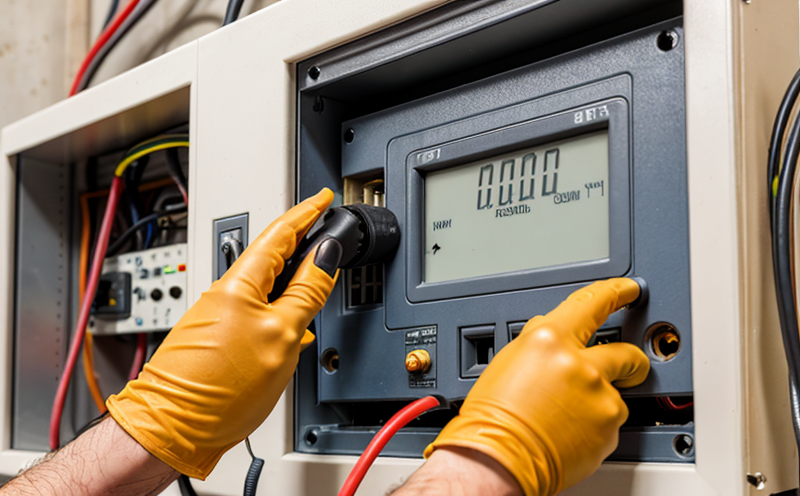ASTM F3146 Electrical Performance Testing of Lithium-Ion Batteries
The ASTM F3146 standard provides a comprehensive approach to assessing the electrical performance of lithium-ion batteries. This testing method is particularly crucial for ensuring that these batteries meet stringent quality and safety standards, which are essential in the automotive, aerospace, consumer electronics, and medical sectors.
ASTM F3146 covers various tests including charge-discharge cycles, internal resistance measurement, capacity retention, impedance analysis, and voltage and current monitoring. These parameters are critical for evaluating the battery's performance over its lifecycle. Charge-discharge cycling helps determine how many times a battery can be used before it needs replacement. Internal resistance is also a key factor as it affects the battery's efficiency during operation.
Impedance analysis, another important aspect of ASTM F3146, provides insights into the electrical behavior of the battery at different frequencies. This test helps identify potential issues such as aging or degradation before they become significant problems. Voltage and current monitoring ensures that the battery operates within safe limits during both charging and discharge processes.
When preparing for ASTM F3146 testing, it is important to follow strict procedures outlined in the standard. The specimen must be properly conditioned according to its intended use, ensuring accurate results. Conditioning involves specific temperature and humidity levels that simulate real-world conditions under which the battery will perform. Proper conditioning ensures that any observed performance issues are due to intrinsic properties of the battery rather than external factors.
The testing equipment required for ASTM F3146 includes high-precision measuring instruments capable of accurately recording voltage, current, resistance values, and other relevant parameters throughout each test cycle. These devices should be calibrated regularly to maintain precision and accuracy in measurements. Calibration ensures that all readings are consistent with industry standards.
Data collected during ASTM F3146 testing is analyzed using statistical methods to determine whether the battery meets specified performance criteria. Results must comply with international standards like ISO, ASTM, EN, IEC, etc., to ensure compatibility across different markets and applications. Compliance with these standards ensures that the battery performs reliably under diverse operating conditions.
The findings from ASTM F3146 testing play a vital role in product development by identifying areas where improvements can be made. By understanding how batteries behave during various stages of their lifecycle, manufacturers can develop longer-lasting products that meet customer expectations while maintaining safety standards.
Industry Applications
Automotive: Ensures reliable power supply for electric vehicles and hybrid cars.
Aerospace: Guarantees consistent performance in space missions where reliability is paramount.
Consumer Electronics: Provides durability assurance for portable devices like smartphones, laptops, etc.
Medical Devices: Ensures safe and efficient operation of life-saving equipment used in hospitals.
The results from ASTM F3146 testing are invaluable across these industries as they help manufacturers produce high-quality batteries that meet strict regulatory requirements. This not only enhances product performance but also contributes to environmental sustainability by reducing waste associated with premature failures.
Why Choose This Test
Comprehensive evaluation: ASTM F3146 offers a holistic view of battery electrical performance, ensuring all critical aspects are addressed.
International recognition: Compliance with this standard ensures compatibility across global markets and regulatory frameworks.
Informed decision-making: Provides valuable data for product development, allowing manufacturers to make informed decisions based on real-world testing.
Safety assurance: Ensures that batteries operate safely within specified limits, reducing the risk of accidents or malfunctions.
The rigorous nature of ASTM F3146 testing sets it apart from other methods by offering precise and reliable results. It is a trusted choice for those seeking to ensure their products meet high-quality standards while maintaining safety and reliability.
Customer Impact and Satisfaction
The outcomes of ASTM F3146 testing significantly impact customer satisfaction in several ways:
Better product performance: By identifying potential issues early on, manufacturers can deliver products that perform consistently.
Increased trust: Compliance with international standards builds confidence among consumers who rely on these products for their daily activities or critical functions.
Extended lifespan: Optimizing the design through testing extends the operational lifetime of batteries, which translates into lower replacement costs and reduced waste.
In summary, ASTM F3146 electrical performance testing is an essential tool that enhances customer satisfaction by delivering reliable products that meet stringent quality and safety standards.





